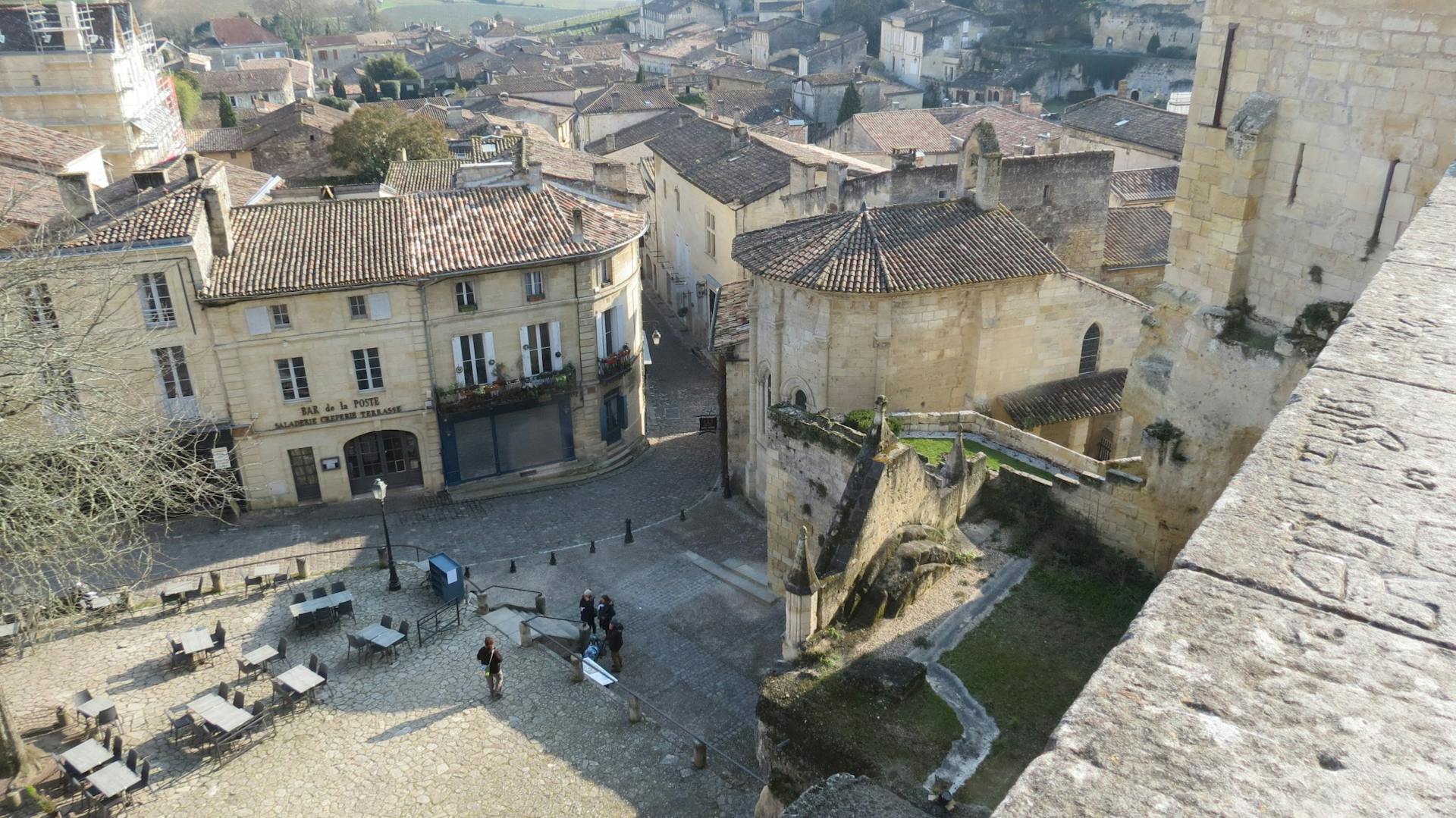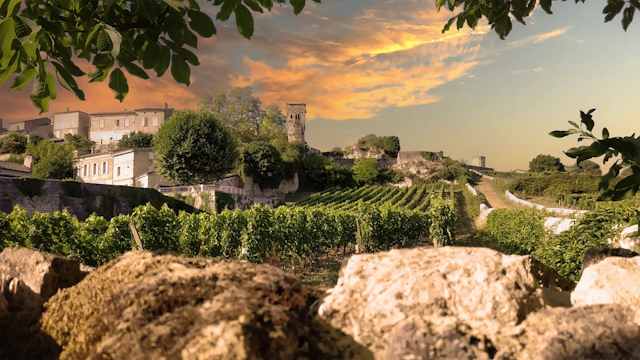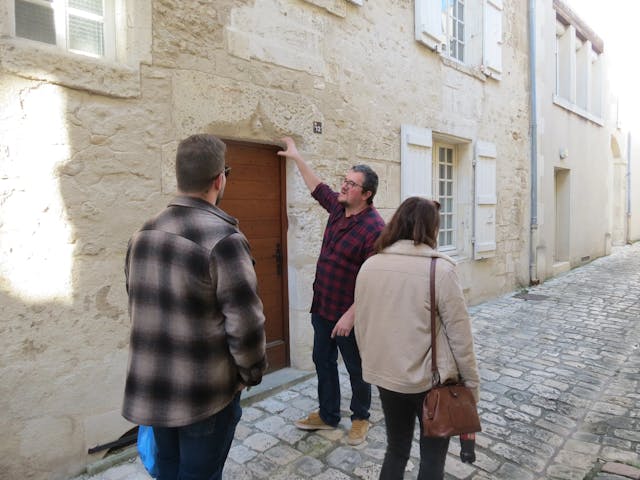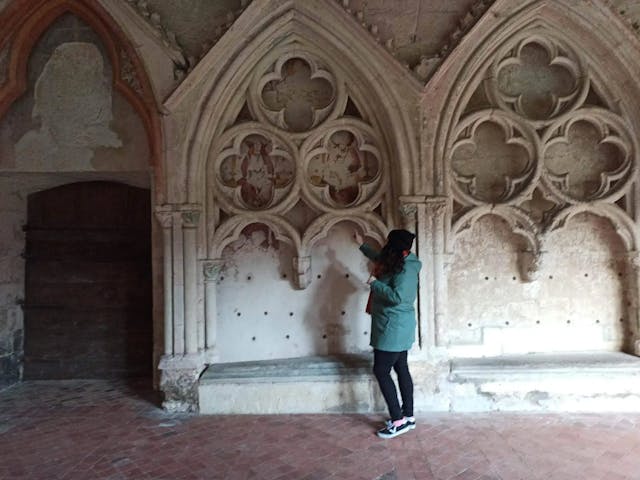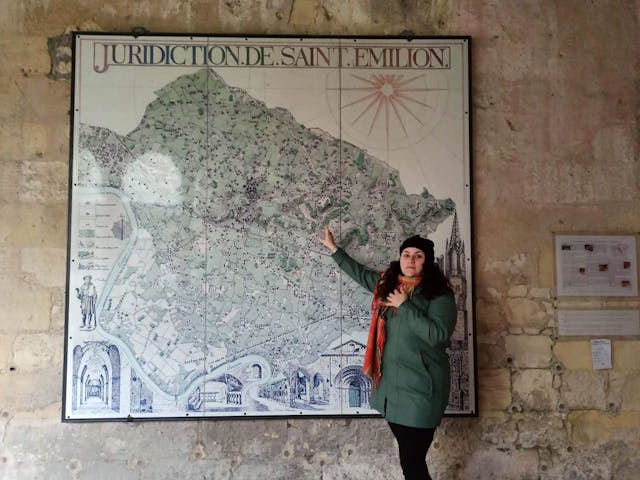To celebrate our brand-new site, we decided to make a little gift for all of you. We created a free self-guided tour of Saint Emilion (by a professional guide.) The concept is simple. By following the instructions in this article, you can quickly stroll through the cobbled streets of Saint Emilion. Learn more about the city’s history and visit this UNESCO-labelled town’s highlights. And most importantly, on your terms and at your own pace. This city tour will take you around 45 minutes and will take you through the must-see monuments in Saint Emilion. You will find a brief history of them and what the best route to take is.
Tip: Don’t forget to wear comfortable shoes. Have a water bottle, in summer, temperatures get quite high, and there are no trees for shadow.
Useful to know: How to get to Saint Emilion from Bordeaux

It all began with a modest monk named Emilion
Start your tour at the Tourist Office. It is located in the town centre, then makes your way to the bell tower in front of it. You are looking at one of the panoramic views of the city. Here is where our story begins…..

To properly understand how the city of Saint Emilion came to be we will go back 30 million years ago. During this time, this region was covered by a vast ocean. When the ocean retracted, it left behind a huge limestone plateau made out of sediments and shells from marine life.
We know that humans have long occupied the area around the current city of Saint Emilion. But the first settlers in this exact spot came in the 8th century. Or should I say settler? A benedictine monk. His name was Emilion, the monk who gave this city its name. A man who came here on a quest to get closer to god, he took refuge in the local caves. He decided to stay and live his last days here, inevitably attracting more and more people with his mysterious persona.
If you look down and to the side, you will see the chapel of the Trinity. Just underneath is hidden the famous Saint Emilion Hermitage, where the monk first found shelter.
If you turn around, you will be able to see the Bell tower of the monolithic church. With its 196 steps, this construction is the first thing you see when you arrive in Saint Emilion. The Bell Tower was built in the 12th century to indicate the presence of the Monolithic church that is just beneath our feet. The Monolithic church of Saint Emilion is considered to be the largest monolithic church from the Middle Ages in Europe.

The Collegiate church of Saint Emilion and its magnificent cloister
Next, you will continue your tour, crossing the square opposite you. Next to the tourism office is the entry to the cloister of the Collegiate church. This medical cloister is 28.5m long on each of its four sides. It is the only one in the Gironde department that is fully preserved. The church was the heart of the monastic life. It was a place where the monks would have to spend a lot of their time -praying and meditating.

Go around the cloister, and you will see that on the other side, there is a beautiful fresco called “The Apocalypse” by François Peltier. On the right side, you will see the other entry to the cloister leading you inside the Collegiate church.

A little historical context
The reason for the construction of a second church in Saint Emilion (after the monolithic) is quite complex. In the second half of the 11th century, the Gregorian reforms changed quite a bit the religious structures in the churches and monasteries. At the time, the lay powers, such as kings and lords were the ones appointing positions in the church. The papacy, however, demanded that they take over the responsibility for the clergy. The archbishop of Bordeaux demanded the construction of the Collegiate church after a warning Saint Emilion was overtaken by the laity. Also, the monks taking care of the Monolithic church, which was the parish church at the time, were not following any religious rules or canons (some of them were said to have had wives and children, for example.)

The story of Saint Emilion and who he was
You are walking into one of the most impressive churches in Gironde. It is quite a sight with its 79m (260ft) long and 30m (100ft) wide. We invite you to look around and explore the many religious scenes and symbols around the church. There is a particularly well-preserved fresco that depicts the trails of Saint Cathrine.

If you follow the path to the heart of the church and to the left you will be able to discover a little status of a humble monk (even though here he is depicted in a gorgeous robe) – Saint Emilion. Emilion is originally from Vannes in Britain and was in the survives of the local viscount. Emilion was known for being very kindhearted. He often stole bread from his master’s kitchen to feed it to needy people. But one day, he was caught red-handed while exiting the kitchen. Guards asked him to show what he was carrying hidden underneath his robe.

Emilion prayed for a miracle… And when he opened his robe, to the surprise of everyone, it wasn’t the bread he was suspected of stealing underneath but pieces of wood. They let him go, and once far away from his master Emilion is said to have transformed the wood back into bread in order to feed the hungry. Emilion then left his native city, and after a brief stay in a monster in Charente where he became a benedictine monk, he ended up here – in what was in the 8th century known as Ascumbas, a vast forest.

You can exit through the north gate of the church. If you look up, you can see that the tympanum on the top, depicting the last judgment, is quite damaged. The reason for the missing head of all the saints is the French Revolution.

Medieval Remparts of Saint Emilion
Continue to your right, where you will be able to take a look at the city’s Rempards. Built in the 12th century by the English, they were protecting the medical city of Saint Emilion. From the 1.5 km of ramparts and seven city gates, only around 600m and one gate are left today. You can also notice something very strange when it comes to the city wall of medieval Saint Emilion. There are a lot of openings on it -windows and doors, the reason being that at the time they were built, the walls were not so much a defensive feature but showed the power and wealth of the city. During wars, those openings had to be enclosed and covered.

The Great Wall of the Dominican Monastery
Lift your eyes to the south, and you will be able to see the ‘Great Wall’ of Saint Emilion. Researchers believe this is what is left of the Dominican monster that was once constructed here in the 13th century. The reason why a lot of it is missing is still debatable. It was either never finished, or it was destroyed, but the reason why this monster is not here today is one – the hundred years war. Since the time Saint Emilion was English, people were afraid that during war times, all outside buildings could be used by the French to attack the city – so everything outside of the city walls was destroyed.




After a short walk, following the outside of the city ramparts, you will arrive at Porte Saint Martine, named after the comune of Saint Martine de Mazerat, which is not far from here. If you look carefully, you will notice a locked door leading to the sentinel road that the soldier would have used to patrol.

The Ursuline convent and the secret of the macaroons
Further down the street, you will notice what is left of the Covent of the Ursuline sisters. The Italian order, carrying the name of Saint Ursula, was established in the 16th century. The sister cared for the area’s poor and underprivileged girls, giving them housing and education. unfortunately during one of the dark periods in the history of the city, most of the girls and sisters in the convent were taken by the black plague. After the French Revolution, the Ursuline sisters were chased away from the city like all the other religious communities in Saint Emilion.

The legend says that only one of the sisters stayed here. She exchanged a very important recipe for a local dessert for housing and food to survive. We can thank her for the reply to the Macarone of Saint Emilion. A Local delicacy that you must taste for sure, made out of sugar, egg yolks and almond powder.
Who keeps the Kings keep?
On the other side of the Ursuline Convent is a Romanesque-looking defensive keep known as the king’s keep or the king’s tower. The only Romanesque still in the region is 14 m high, 9 meters wide, and has three levels. Historians still argue who built the King’s keep in 1428- the French or the English. With its 118 steps and stern guardianship over the city, it looks like it had defensive purposes, but this probably was not the case. For one, it was within the city walls and the windows were located toward the city.

Whether the French or the English kings built it, it was most likely used to show the power and means of the ruler at the time. It might have also been built by the town counsellors (Jurade) to honour the king, and the keep was used for meetings.

The Cordeliers and their sparkling wine
Here, you have your second Panoramic view of the city. If you look on the opposite side from you, you will notice the Cordeliers – the remanence of a Franciscan monastery that was built here in the 13th century. The set consisted of a church, a cloister, a garden, a winery, a cellar, a courtyard and a main building. The Franciscan monks were also expelled from the city during the Revolution, and the convent was sold as a national property. Nowadays, the building is used as the base for producing and distributing Crémant de Bordeaux – a lovely, sparkling wine.


A wash house to talk about
Take the stairs on the side to descend to the lower part of the city. Here, you can observe the washhouses. Numerous wells and fountains exist around the city, and we know that even in the 8th century, a water source had already come through the city. The 19th century marked the transformation of said water springs into washhouses. This was a very central place for the city as many habitants were coming here to rinse their linens and exchange information. The bigger washhouse was probably covered and was used by the washwomen of the richer part of the population, even though the water came from the same source.

After a quick walk through one of the boutique streets of the city, you will finish your tour at the Monolithic church.
We left the best for last – The Monolithic church.
You have arrived in front of the Monolithic church of Saint Emilion. Mono lithos means one stone or formed of a single large block of stone because this church was carved into the limestone plateau in the 12th century. The first religious sanctuary was carved into the limestone here a little after 1000. From the beginning, the sanctuary housed a necropolis, where the first grave is dated to 1020 – 1030. The whole area here was a cemetery as people were coming to be buried here, as close as possible to the relics of Saint Emilion.
Now, around the 12th and especially 13th century, Saint Emilion became one of the most important cities in the region. There are multiple reasons for that. The first and maybe most important is that Saint Emilion has a unique geographical position. It is between the two main arteries leading from Galicia in Spain to Santiago de Compostela. There is the road of Saint James that passes through Bordeaux and the other one to Bazas.

For the local lords, it was also of great economic interest to attract the pilgrims here to Saint Emilion. Lodgings, trade, and taxes meant more income for the locals and their viscount. But why would the pilgrims choose to detour here, in Saint Emilion?

What would a pilgrim need during his long journey to Galicia? A place to sleep, a place to dine and a divine inspiration to continue their holy way to Santiago de Compostela. Here is where the lords of this land excelled. They gave the pilgrims all that and someone to worship and pray to on their way to Santiago de Compostela.
In the 12th century, the viscount of Castillon, Pierre de Castillon, chose to carve a church instead of building one, and it paid off as the church quickly became well known amongst the pilgrims and travellers. The monolithic church of Saint Emilion nowadays is known as the vastest monolithic church from the Middle Ages in Europe. I know that from the outside, it looks modest, but I assure you this is not the case as the church is 39m (128ft) long, 20m (65ft) wide and 12m (39ft) high.
Tip: The only way to visit the underground of Saint Emilion is with a guide.
Saint Emilion got the prestigious UNESCO level in 1995. It has more than a million visitors from all around the world each year.
This concludes our short but sweet visit. This free self-guided tour of Saint Emilion allowed you to look into our town’s intriguing history quickly. If you want to learn more, you can look into our many articles here.
If you want to visit Bordeaux and Saint Emilion with a state-certified, wine-loving, local guide, consider booking one of our amazing Wine tours HERE!
Download a city map provided by the tourism office here: link
